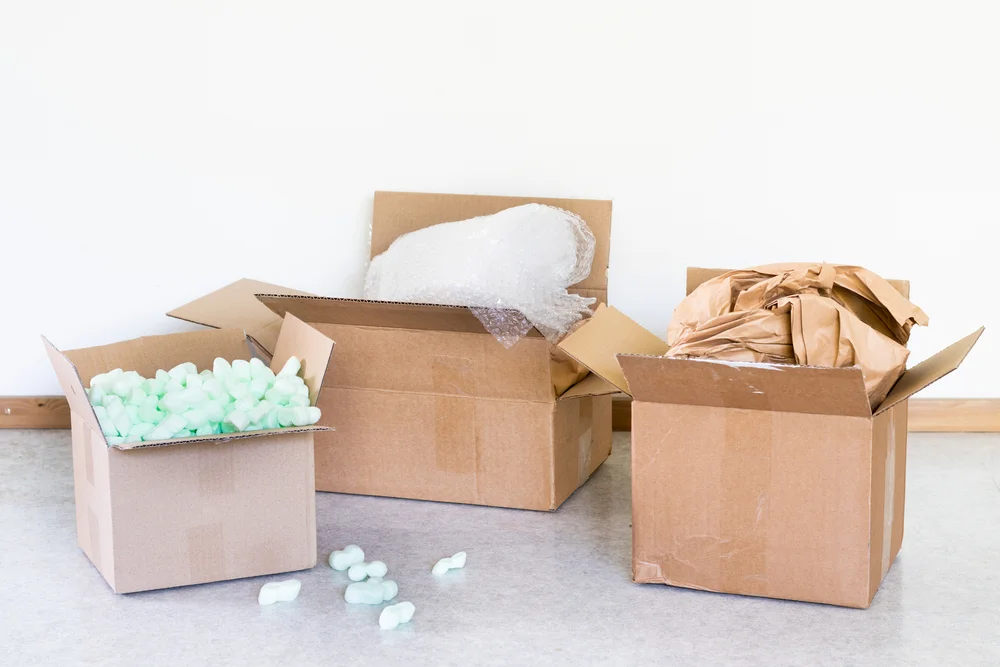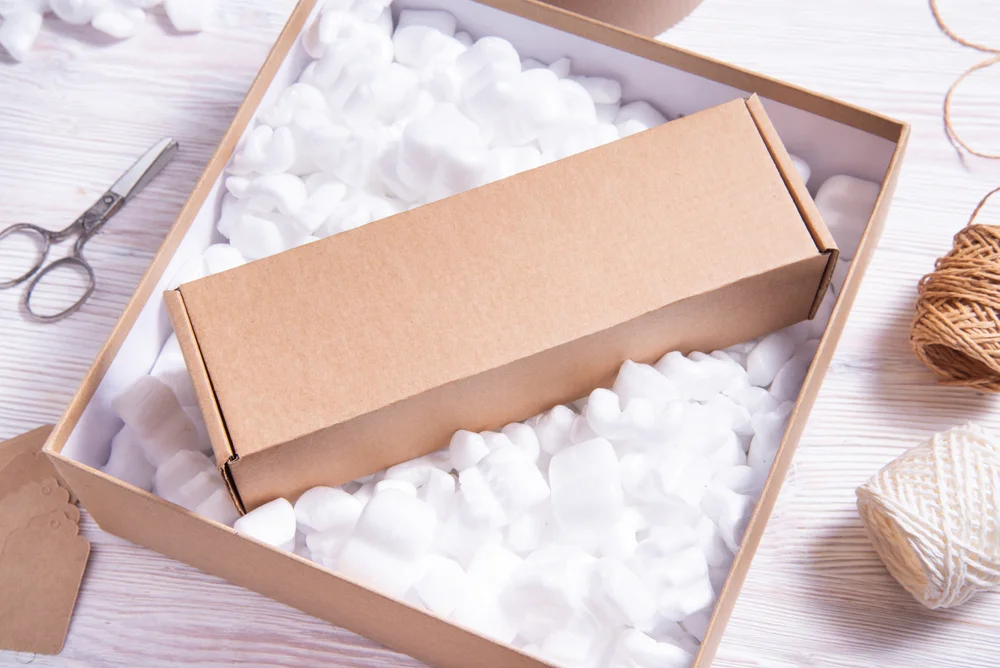Styrofoam And Recycling Packaging Peanuts
Styrofoam and recycled packaging peanuts are both materials commonly used in packaging, but they have different considerations regarding sustainability and recycling.
Styrofoam:
- Styrofoam is a type of expanded polystyrene foam, often used for packaging due to its lightweight and protective properties.
- Recycling options for Styrofoam vary by location. Some facilities accept clean and dry Styrofoam for recycling, while others may not.
Packaging Peanuts:
- Packaging peanuts are often made from expanded polystyrene foam or biodegradable materials like cornstarch.
- Traditional expanded polystyrene packaging peanuts are not easily recyclable, and their small size can make them challenging to manage in recycling facilities.
- Biodegradable packaging peanuts made from cornstarch or other natural materials break down in water and are often compostable.
- Some shipping and packing stores may accept clean and reusable packaging peanuts for reuse.
- When disposing of packaging peanuts, it's best to consider reuse options first or to follow local guidelines for proper disposal.

Biodegradable packing peanuts Vs.Styrofoam packing peanuts
The comparison between biodegradable packing peanuts and Styrofoam packing peanuts:
Biodegradable Packing Peanuts:
- Material: Biodegradable packing peanuts are usually made from natural materials like cornstarch, wheat, or potato.
- Environmental Impact: Biodegradable peanuts break down more easily and quickly in natural environments, reducing their long-term impact on ecosystems.
- Disposal: They can often be composted at home or in industrial composting facilities, contributing to nutrient-rich soil.
- Drawbacks: They might dissolve or become damaged when exposed to moisture, potentially affecting their protective properties.
Styrofoam Packing Peanuts:
- Material: Styrofoam packing peanuts are made from expanded polystyrene foam, a petroleum-based material.
- Disposal: Most curbside recycling programs do not readily accept Styrofoam peanuts due to their lightweight nature and contamination risks.
- Reuse: They can be reused for packing and shipping if kept clean and contamination-free.
- Benefits: They provide excellent cushioning and protection for fragile items during shipping.
- Drawbacks: Styrofoam is not environmentally friendly, doesn't break down quickly, and can contribute to litter and harm to wildlife.

Styrofoam packing peanuts are effective for cushioning but have negative environmental consequences.
The Issue with Conventional Packaging:
Conventional packaging often poses significant environmental and social challenges:
- Waste Generation: Excessive packaging creates substantial waste, contributing to landfills and pollution.
- Resource Depletion: Conventional packaging relies on finite resources like fossil fuels for plastics and trees for paper, contributing to resource depletion.
- Plastic Pollution: Plastic packaging, especially single-use items, contributes to the pervasive problem of plastic pollution in oceans and ecosystems.
- Toxicity: Some packaging materials release harmful chemicals during production and disposal, potentially harming human health and the environment.

Why Is Sustainable Packaging Important?
Sustainable packaging addresses these issues and offers several key advantages:
- Reduced Waste: Sustainable packaging minimizes waste using recyclable, biodegradable, or compostable materials.
- Resource Conservation: It focuses on renewable resources, reducing reliance on non-renewable materials.
- Lower Carbon Footprint: Sustainable packaging uses materials and processes that generate fewer greenhouse gas emissions.
- Ecosystem Protection: Sustainable packaging helps protect ecosystems and wildlife by minimizing pollution and waste.
- Consumer Demand: Increasingly, consumers prefer products with eco-friendly packaging, leading to positive brand perception.
- Regulatory Compliance: Many regions are implementing regulations to promote sustainable packaging practices.

Pros and Cons of Biodegradable and Styrofoam packing peanuts
Biodegradable Packing Peanuts:
Pros:
- Environmental Friendliness: Biodegradable peanuts break down naturally, reducing long-term environmental impact and pollution.
- Composting: They can often be composted, contributing to nutrient-rich soil and minimizing waste.
- Positive Brand Image: Using biodegradable packaging aligns with sustainability goals, enhancing your brand's reputation.
- Dissolve in Water: They dissolve in water, reducing the risk of litter and pollution in aquatic environments.
Cons:
- Moisture Sensitivity: Biodegradable peanuts can dissolve or lose their cushioning properties when exposed to moisture.
- Limited Reusability: They may not be as durable for reuse as Styrofoam peanuts.
- Composting Facilities Needed: Proper composting facilities are required for effective decomposition, which might not be available everywhere.
- Cost: Biodegradable options can sometimes be more expensive than traditional Styrofoam.
Styrofoam Packing Peanuts:
Pros:
- Excellent Cushioning: Styrofoam peanuts provide superior cushioning and protection for fragile items during shipping.
- Reuse Potential: They can be reused multiple times for packaging due to their durability.
- Cost-Effective: Styrofoam peanuts are often more affordable compared to some biodegradable alternatives.
- Lightweight: They contribute less to shipping weight, potentially reducing transportation costs.
Cons:
- Environmental Impact: Styrofoam is not biodegradable and can persist in the environment for a long time, contributing to pollution and litter.
- Recycling Challenges: Styrofoam peanuts are often not accepted in regular recycling streams due to their lightweight nature and contamination risks.
- Toxic Chemicals: Production and disposal of Styrofoam can release harmful chemicals into the environment.
Choosing between these two options depends on your priorities and values. If environmental impact and sustainability are crucial, biodegradable peanuts may be the better choice. However, Styrofoam might be more suitable if you prioritize durability and reuse potential.

Eco-Friendly Packaging Alternatives for Your Business
Embracing eco-friendly packaging alternatives can enhance your business's sustainability and appeal to environmentally conscious consumers. Here are several options to consider:
- Biodegradable Packaging: Utilize packaging materials made from biodegradable substances like cornstarch, sugarcane, or wheat straw. These materials break down naturally, reducing long-term environmental impact.
- Compostable Packaging: Compostable plastics and plant-based films can be broken down in industrial composting facilities, contributing to nutrient-rich soil.
- Recycled Materials: Opt for packaging made from recycled materials, reducing the demand for virgin resources and minimizing waste. Recycled cardboard, paper, and plastic are common choices.
- Minimalist Design: Use minimal packaging that eliminates excess materials and focuses on functionality. This reduces waste and emphasizes your commitment to sustainability.
- Reusable Packaging: Introduce reusable packaging options that customers can use multiple times, such as tote bags, cloth pouches, or containers.
- Paper-based Solutions: Choose paper-based packaging like corrugated boxes, paperboard sleeves, and wrapping paper. These materials are renewable and often recyclable.
- Plant-based Plastics: Consider using bioplastics derived from renewable resources like corn or potatoes to reduce reliance on fossil fuels.
- Mushroom Packaging: Explore mushroom-based packaging materials, which are biodegradable and require less energy.
- Edible Packaging: Innovative options like edible packaging made from seaweed or rice can be consumed along with the product or biodegrade naturally.
- Upcycled Packaging: Utilize upcycled materials like reclaimed fabric, cardboard, or other discarded items for unique and sustainable packaging solutions.
- Custom Box Sizes: Tailor your packaging sizes to match the product dimensions, reducing excess space and materials.
- Sustainable Inks and Labels: Use eco-friendly inks and labels with minimal environmental impact for printing product information and branding.
- Eco-Friendly Fillers: Replace Styrofoam peanuts with biodegradable or reusable fillers like shredded paper, air pillows, or fabric scraps.

Benefits of Packing Peanut Over Bubble Wrap
Packing peanuts and bubble wrap are popular packaging materials, each with its own benefits. Here are the advantages of using packing peanuts over bubble wrap:
Benefits of Packing Peanuts:
- Customized Fit: Packing peanuts easily conform to the shape of the packed item, providing a snug fit that helps prevent movement and potential damage during transit.
- Cushioning: Peanuts offer excellent shock absorption, distributing impact forces evenly and reducing the risk of breakage for fragile items.
- Fill Void Spaces: Peanuts can effectively fill voids within a package, ensuring that items remain secure and reducing the chances of shifting during transportation.
- Weight Distribution: The lightweight nature of packing peanuts adds minimal weight to the package, which can help keep shipping costs lower.
- Versatility: Packing peanuts can be used for various products, from small, delicate items to larger, more irregularly shaped items.
- Eco-Friendly Options: Biodegradable and compostable packing peanuts made from materials like cornstarch are available, offering an environmentally friendly alternative.
- Reusable: If handled carefully, packing peanuts can be reused multiple times for various packaging needs, reducing waste.

Q: Where do you buy popcorn or peanuts for packaging?
You can buy packaging peanuts from various sources, including packaging supply stores, shipping stores, online retailers, and wholesale suppliers. Ensure you choose a reputable seller.
Q: What to do with packaging peanuts?
Packing peanuts can be reused, donated to local shipping stores for others to reuse, or taken to designated drop-off locations for recycling.
Q: What is the best packaging for peanuts?
Packaging peanuts requires a sturdy cardboard box or container that provides proper cushioning and protection.
Q: Why aren't packing peanuts used anymore?
Traditional polystyrene packing peanuts are being used less due to environmental concerns.
Q: Are packing peanuts worth it?
Packing peanuts can provide effective cushioning and protection for fragile items during shipping, but their worth depends on your specific packaging needs and environmental considerations.
Q: What are the cons of packing peanuts?
Cons of traditional packing peanuts include environmental concerns, difficulty in recycling, and the potential for static electricity buildup, which can be inconvenient.
Q: Is bubble wrap or packing peanuts cheaper?
Costs can vary depending on factors like quantity and supplier. Generally, bubble wrap might be more cost-effective as it comes in rolls and covers larger areas, while packing peanuts are often sold in bulk by volume.